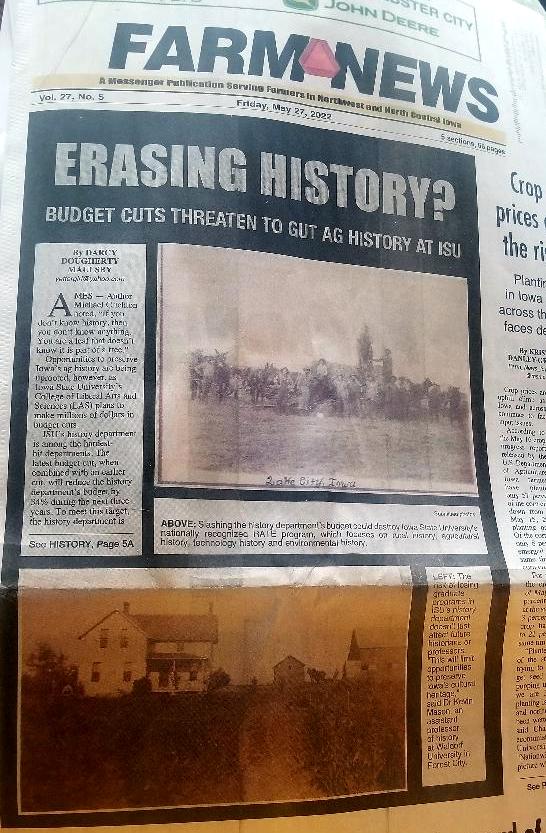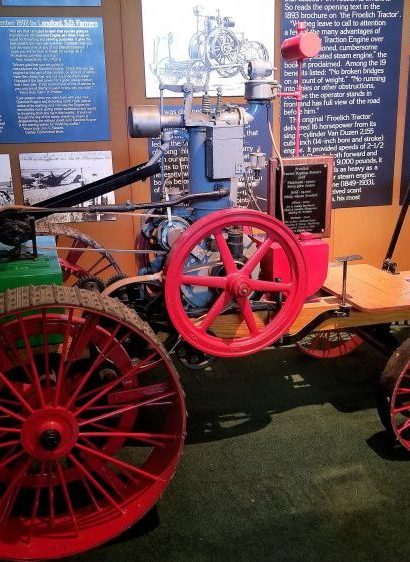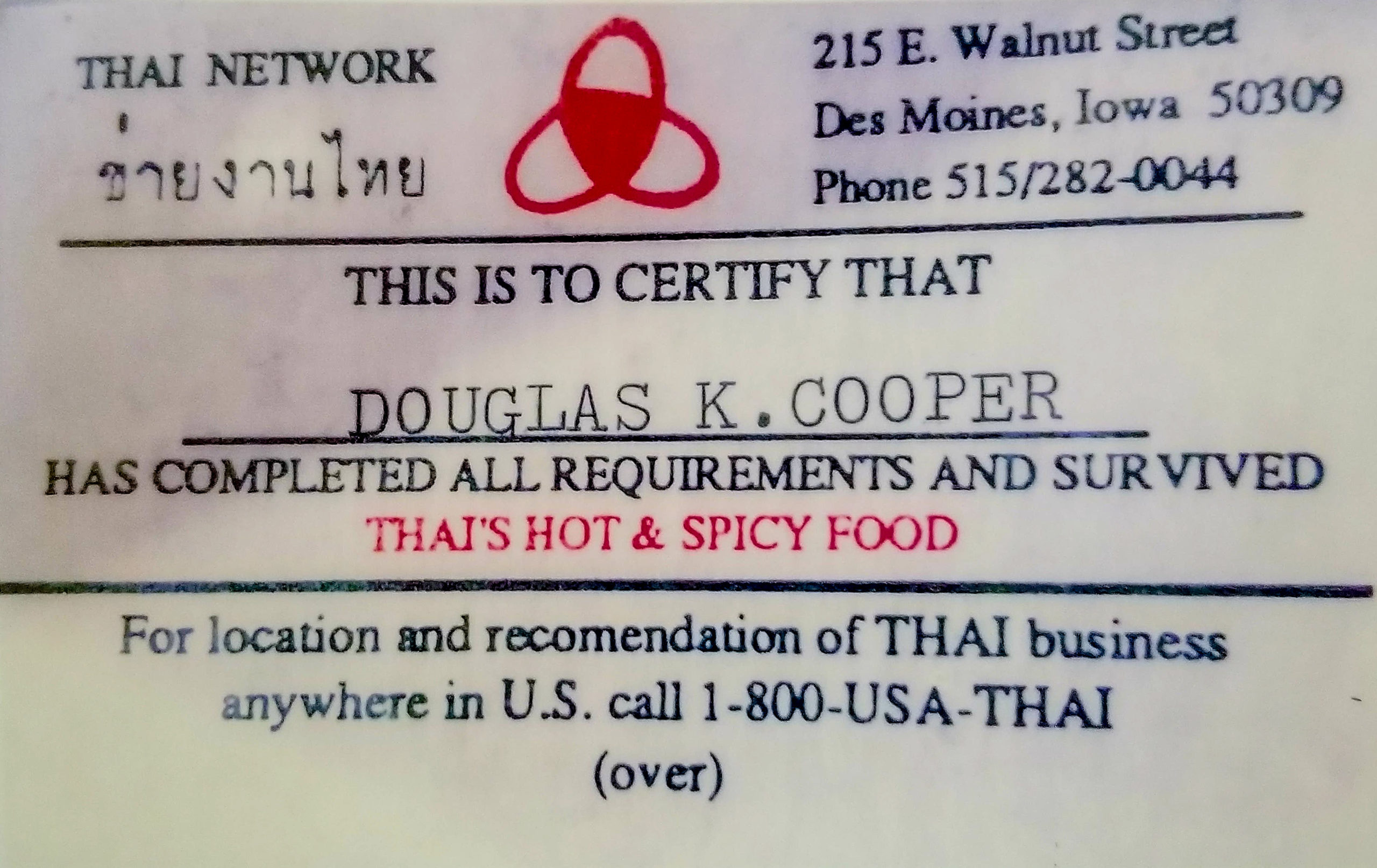Category: Communication Tips

Do Press Releases Still Work?
A few years ago I was at a marketing seminar when the discussion turned to whether press releases are still useful. Most of the attendees shook their heads no, and a few vocalized their scorn with comments like “are you kidding?”
Well, I’ve got news for you (pun intended). As a trained journalist who still appreciates receiving press releases, and as a marketing specialist who writes and distributes them on behalf of clients, press releases still work—and they can work well when they are done right.
If you’ve got news to share, don’t overlook the power of a well-written press release that offers “one-stop-shopping” for today’s media outlets, which tend to be understaffed, overworked, underpaid and grateful for a helping hand to keep audiences informed.
It reminds me a comment I heard from a marketing expert once. “If you have a message that matters, it’s your responsibility to make sure that message is heard, remembered and acted upon.”
Here are my top 10 tips to help you get more media coverage (think free publicity!) when you have a message that matters:
1. Think like a journalist. Not sure what to talk about? What news have you been sharing with friends, family and current customers? Have an event coming up? Tell the media about it. Also, don’t be afraid to time your news releases with events in the wider world. I recently listened to a radio interview with a local florist in early February. This small business owner said Valentine’s Day is like the Super Bowl of the flower business. What a great news hook!
2. Craft a clear, compelling headline and subhead. This is the most important part of your press release, so spend some time on this. (Hint—the headline can also be the subject line of your email to send the press release.) Imagine you have $1 to spend on a press release. Invest 95 cents of that dollar in a strong headline. While you want your headline to grab attention, it’s important that it does so while also explaining exactly what your announcement is about. It’s at this point the editor or reporter will decide to continue reading or not.
This isn’t the time to be overly creative or vague. Your headline should appear in bold followed by a sub-headline in italics. For example, in a recent story I wrote about an Iowa distillery, the headline read Cheers to Iowa Ag, while the sub-head read: Century Farms Distillery in Spencer Makes High-Quality Bourbon, Whiskey from Customers’ Corn.
3. Don’t forget to add your contact information. Put this right up front, below the headline, so people know exactly who to contact for more details. Here’s a simple example: Contact: Joe Smith, general manager, 515-555-5555, jsmith@xyzcoop.com/.
4. Grab attention from the opening paragraph or two. This section should answer the five Ws and one H: who, what, where, why, when and how. Even if readers stopped here, they’d have all the necessary information you’re trying to communicate. Here’s an example from a corporate press release I wrote a few years ago:
A new soybean crushing plant that will be built at the Butler Logistics Park northwest of Shell Rock, pending state and local approvals, will propel value-added agriculture forward in Iowa. Mid-Iowa Cooperative, a farmer-owned cooperative based in east-central Iowa, is leading the effort to create Shell Rock Soy Processing (SRSP), LLC. When operational in 2022, this plant will crush 38.5 million bushels of soybeans annually, or 110,000 bushels daily and will create 50 to 60 high-quality jobs.
5. Include a compelling quote early on. Following the lead paragraph(s), include a quote from whoever is the most relevant spokesperson. If you’re a small-business owner, it’s most likely to be you. This is a great opportunity to “speak human” and add key insights that go beyond “just the facts.” Here’s an example for a press release I wrote for a small business in Madison County, Iowa, that was showcasing succulents and container gardens at her business:
“What’s old is new again when you focus on recycling and repurposing,” said Susan Appleget Hurst, who was recently featured in Country Gardens ®magazine. “Growing hardy succulents in broken pots way is a fun way to go green in more ways than one.”
6. Add additional details to round out the basics of the story. These additional paragraphs can provide key details that help the audience understand the story better. It might take only three or four additional paragraphs to cover the pertinent information, or it could take a dozen. Each news release is unique, so use your best judgment. Remember, think like a journalist or someone in the audience who is hearing this news for the first time. What questions might they have? What details would be useful to help them understand why your story is important?
7. Include the boilerplate. This is a paragraph goes at the end of the press release and contains essential background information about your company. Think of the boilerplate as your elevator pitch, or a shorter version of your “About Us” page.” Make sure it includes a link to your website. Here’s an example from that Shell Rock Soy Processing press release:
About Mid-Iowa Cooperative: We know trust is earned, never given. Since the merger of area farmer-owned cooperatives in 1996 that created Mid-Iowa Cooperative, we have experienced record growth, putting us into the top 10% of all Iowa cooperatives in terms of sales and profitability. For more than 75 years, generations of farmers have counted on Mid-Iowa Cooperative, which is rooted in Iowa agriculture. Our diverse client portfolio reaches across the state to serve more than 1,400 members. We are also the largest direct-ship farm-to-market grain procurement company in the Midwest. As a farmer-owned cooperative, we offer products and services in grain management, marketing, insurance and feed. For more information, visit www.midiowacooperative.com.
8. Include visuals to help illustrate your story. These can include photos, artist’s renderings, logos, charts and other illustrations. The media love these graphics. They make it easy for a print outlet like a newspaper or magazine to offer a complete story. Don’t think pictures are just for print, though. Radio stations also want relevant visuals to include on their social media posts when they share news. You can either send these as attachments in the email announcing your press release, or note that visuals are available upon request (and include the appropriate contact info so the media can follow up). You can also have the graphics in a special section of your website or a cloud-based file like Google Drive and share that link when you email the press release.
9. Think about creating a Q&A, or FAQ to go along with your news release. This can be a separate document you send along with your press release. It can be especially helpful if the news you’re announcing is fairly complex or detailed. A Q&A (which could also be considered a Frequently Asked Questions resource) can help supply key background info about your business, not only to the media, but to potential customers. Consider adding this Q&A or FAQ to your website, or create a handout, brochure or sales sheet to give to prospects. Also consider posting this info. bit by bit over time on your social media page to get your message out.
10. Be available to the media. This sounds obvious, but you’d be amazed at how hard it can be to get ahold of some sources, even when they send out a press release and invite followup from the media. If a reporter contacts you, get back to them as soon as possible. It’s okay to buy a little time, if necessary. Just say, “Thanks for reaching out. I’d love to chat with you, but I’m busy right now. I’ll get back in touch by (TIME OR DATE) so we can find a time to visit.”
Here are a few examples of press releases I’ve worked on through the years to give you an idea of how to structure these properly:
EXAMPLE 1:
Madison County Entrepreneur Picks Up the Pieces:
Applehurst in Winterset Showcases Succulents, Container Gardens
Contact: Susan Appleget Hurst, phone 555-555-5555, email@email.com
WINTERSET, Iowa – Aug. 14, 20XX—Forget everything you know about picking up the pieces. Susan Appleget Hurst is offering an inspiring new spin, thanks to her distinctive tabletop succulent displays made from discarded and broken terra cotta pots.
“What’s old is new again when you focus on recycling and repurposing,” said Appleget Hurst, who was recently featured in Country Gardens ®magazine. “Growing hardy succulents in broken pots way is a fun way to go green in more ways than one.”
As the succulents grow, they fill in the spaces between the shards, said Appleget Hurst, who traded in a career at Meredith publishing to run her own business, Applehurst, in Winterset, Iowa (home of the famous Bridges of Madison County).
These distinctive cracked-pot creations become an expression of creativity, thanks to six simple steps that turn broken pots into unique container gardens. Even better, the hardy succulents can be overwintered to provide years of enjoyment.
Appleget Hurst shares her secrets for designing cracked-pot succulent gardens not only in fall 2013 issue of Country Gardens magazine, but in the classes she offers at Applehurst, which is housed in the historic 1903 Madison County Jail. Visitors can also purchase ready-made cracked-pot succulent gardens at Applehurst.
Can’t travel to central Iowa? Appleget Hurst welcomes media interview requests and enjoys sharing her simple tips for making cracked pot creations.
*** The attached photos can be used with this release. High-resolution versions of all the images are available upon request. E-mail susan@applehurst.com for details.
About Applehurst
Applehurst brings the garden, the table and the soul together. Visitors can shop from a selection of kitchen garden plants and tools, wild-bird supplies, award-winning local wines, and Midwest artistry. For more information, visit www.applehurst.com.
EXAMPLE 2
New Soy Processing Plant to Break Ground in Butler County
Contact: Mike Kinley, 555-555-5555, email@email.com
Note: High-resolution images of Mike Kinley, the SRSP logo, artists’ renderings of the SRSP plant and more are available upon request from Sam Smith (email address goes here, 555-555-5555, email@email.com)
SHELL ROCK, Iowa –Oct. 13, 2020—A new soybean crushing plant that will be built at the Butler Logistics Park northwest of Shell Rock, pending state and local approvals, will propel value-added agriculture forward in Iowa.
Mid-Iowa Cooperative, a farmer-owned cooperative based in east-central Iowa, and Mike Kinley, Mid-Iowa’s CEO, are leading the effort to create Shell Rock Soy Processing (SRSP), LLC. When operational in 2022, this plant will crush 38.5 million bushels of soybeans annually, or 110,000 bushels daily and will create 50 to 60 high-quality jobs.
“We’re positioned to extract all the value possible from locally-grown soybeans,” Kinley said. “This plant can supply both food and fuel needs, and it will bring Butler County and surrounding areas into the center of the global ag economy.”
Mid-Iowa will own a portion of SRSP, which will cost approximately $270 million, and is currently seeking investors for the project. Mid-Iowa will also help originate soybeans for the plant, where groundbreaking is slated for late October 2020.
“Not only will SRSP create more than 50 high-quality jobs, but it allows our area to build on its strong agricultural heritage,” said Jeff Kolb, executive director of the Butler-Grundy Development Alliance. “This will help expand farm income potential, and it will diversify the economy, which can benefit everyone.”
SRSP, by the numbers
The facility will produce 847,000 tons of soybean meal per year (2,420 tons per day) for livestock feed markets, 462 million pounds of crude soybean oil per year (1.32 million pounds per day), and 77,000 tons of pelleted soybean hulls per year (220 tons per day). The soymeal and soy hulls (which contain highly digestible fiber) will be used in livestock feed rations.
“SRSP will add tremendous value to soybeans in the eastern part of Iowa,” said Mike Knobbe, an SRSP developing partner with Kinley. “This plant will also benefit the livestock sector by providing high-quality, 48 percent protein soymeal.”
The soybean oil from SRSP can be used for a variety of applications, including the human food industry. Approximately 25 percent of SRSP’s products will be used within Iowa, while 75 percent will be exported outside of Iowa.
SRSP will be able to unload trucks quickly, saving farmers and truckers a great deal of time when they deliver soybeans to the plant. “This soybean crush plant is a farmer’s dream,” said Jeff Reints, who farms in the Shell Rock area with his son, Clay. “Our closest plant is more than an hour away, and it’s notorious for having 3- to 4-hour waits. SRSP will increase demand for soybeans in our area. More profit potential means farmers will likely add more soybeans to their crop rotation.”
Assuming a 50-50 mix of beans by rail or truck, vehicle traffic to and from SRSP will include soybean deliveries from area farmers, as well soybean oil and meal transport. At peak capacity, approximately 150 trucks will access the plant per day. The plant’s close proximity to the Iowa Northern Railway will contribute to efficient traffic-flow patterns around the logistics park.
“Iowa Northern is honored to have a key role in connecting Iowa agricultural communities direct to the North American transportation network,” said Dan Sabin, president of Iowa Northern Railway Company, a Class III, shortline railroad based in Waterloo that serves industries throughout north-central and eastern Iowa. “We’re pleased to partner with Mid-Iowa Cooperative on this dynamic project and look forward to fulfilling our role in its future success.”
Rail cars will also be loaded out with crude soybean meal or oil. At peak capacity, the plant will load/unload approximately 35 railcars per day.
The plant will be built by Minnesota-based Fagen, Inc., the engineering, procurement and construction (EPC) design builder and development partner for SRSP. “It’s a pleasure to work with the Fagen team,” Kinley said. “They are the premiere design-build partner in value-added ag processing.”
This extensive experience will enhance the opportunities generated through the Butler Logistics Park.
“This plant fits so well with this area, since the Flint Hills Resources ethanol plant and TrinityRail Maintenance are already here,” Reints said. “Anytime you can add jobs that keep our rural communities and schools strong, it’s a win-win. We’re really looking forward to the ways this plant will grow the economic base in our rural area for generations to come.”
Plant promotes partnerships, responsible growth
Other farmers agree. “SRSP offers a big opportunity to add value to local soybeans and boost the economy,” said Bob Hogle, a Beaman-area farmer who serves as Mid-Iowa Cooperative’s board president. “It will also help farmers save a lot of time. When you’ve waited in line at a soy processor for four, five or six hours to dump grain, it’s such a waste. MIC knows there has to be a better way. SRSP is a great fit for our area, especially since we’ve unified with East Central Iowa Co-op.”
The right leadership is key to this project, Hogle added.
“Mike Kinley, MIC’s CEO, is a next-generation co-op leader who brings a wealth of experience with projects like this,” Hogle said. “He has the right connections in the industry and management skills that are second-to-none.”
A project of this scale requires a team effort. “Creating SRSP has taken a lot of stakeholders, including local farmers, ag cooperatives, economic development leaders, county zoning officials, the Butler County supervisors and many others,” Knobbe said. “It’s rewarding to see so many people working together to make this plant a reality.”
SRSP will benefit the region for decades to come. “Providing soybean growers with a new option through SRSP isn’t just for today’s farmers,” Hogle added. “It will benefit the next generation, too.”
For more information, log onto www.midiowacooperative.com.
About Mid-Iowa Cooperative: We know trust is earned, never given. Since the merger of area farmer-owned cooperatives in 1996 that created Mid-Iowa Cooperative, we have experienced record growth, putting us into the top 10% of all Iowa cooperatives in terms of sales and profitability. For more than 75 years, generations of farmers have counted on Mid-Iowa Cooperative, which is rooted in Iowa agriculture. Our diverse client portfolio reaches across the state to serve more than 1,400 members. We are also the largest direct-ship farm-to-market grain procurement company in the Midwest. As a farmer-owned cooperative, we offer products and services in grain management, marketing, insurance and feed. For more information, visit www.midiowacooperative.com.
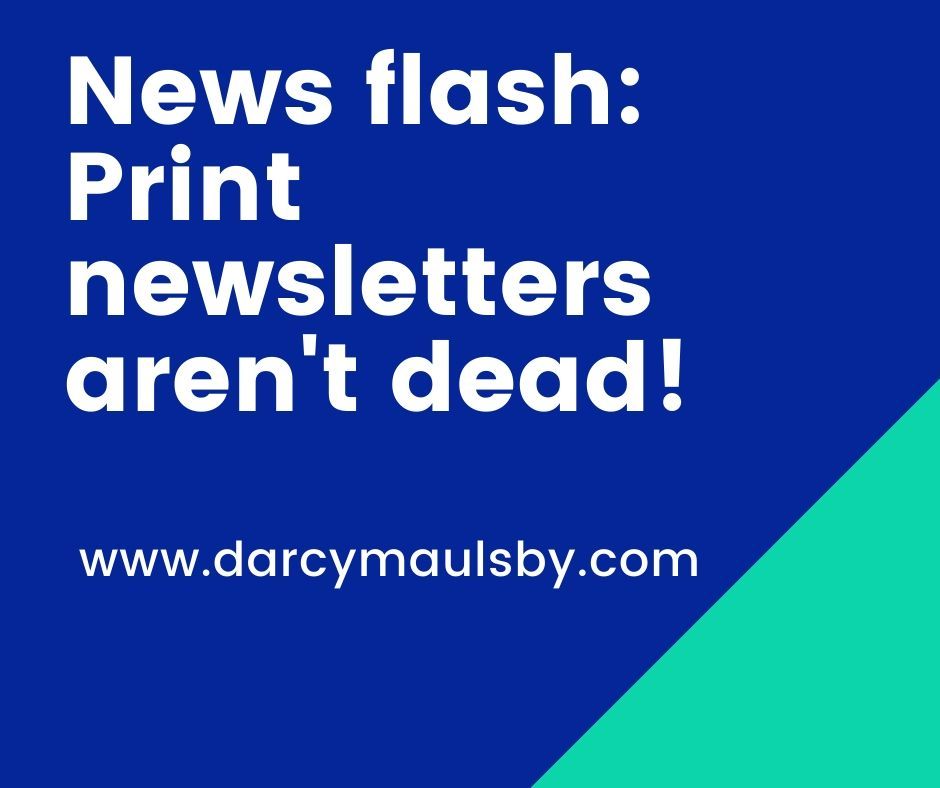
Long Live Print Newsletters! 5 Keys to Content Marketing Success
Notice the farmer said he doesn’t see the name John Deere popping up all over the stories in the magazine. If fact, it’s extremely rare. There’s a reason why. People know when they’re being sold.
If this sounds good, you might be wondering next steps. If you already have a newsletter program, how do you keep it going? If you had one but dropped it, how do you revive it? What if your company never had a newsletter program?
1. Add value. The #1 secret of any successful content marketing, including print marketing, is to add value for your audience. The easiest way to find good story ideas that add value? Become a detective. Ask your co-workers to provide answers to timely questions they are hearing from their clients and prospects. Don’t forget to have them think about the questions they think clients and prospects should be asking but aren’t. Then have your team provide the answers, which make a great foundation for newsletter content.
I know you still may have a lot more questions about content marketing or a print newsletter program. If so, let’s start the conversation.
Want more?
I invite you to read more of my blog posts if you value intriguing Iowa stories and history, along with Iowa food, agriculture updates, recipes and tips to make you a better communicator.
If you’re hungry for more stories of Iowa history, check out my top-selling “Culinary History of Iowa: Sweet Corn, Pork Tenderloins, Maid-Rites and More” book from The History Press. Also take a look at my other books, including “Iowa Agriculture: A History of Farming, Family and Food” from The History Press, “Dallas County” and “Calhoun County” book from Arcadia Publishing. All are filled with vintage photos and compelling stories that showcase the history of small-town and rural Iowa. Click here to order your signed copies today! Iowa postcards are available in my online store, too.
If you like what you see and want to be notified when I post new stories, be sure to click on the “subscribe to blog updates/newsletter” button at the top of this page, or click here. Feel free to share this with friends and colleagues who might be interested, too.
Also, if you or someone you know could use my writing services (I’m not only Iowa’s storyteller, but a professionally-trained journalist with 20 years of experience), let’s talk. I work with businesses and organizations within Iowa and across the country to unleash the power of great storytelling to define their brand and connect with their audience through clear, compelling blog posts, articles, news releases, feature stories, newsletter articles, social media, video scripts, and photography. Learn more at www.darcymaulsby.com, or e-mail me at yettergirl@yahoo.com.
Let’s stay in touch. I’m at darcy@darcymaulsby.com, and yettergirl@yahoo.com.
Talk to you soon!
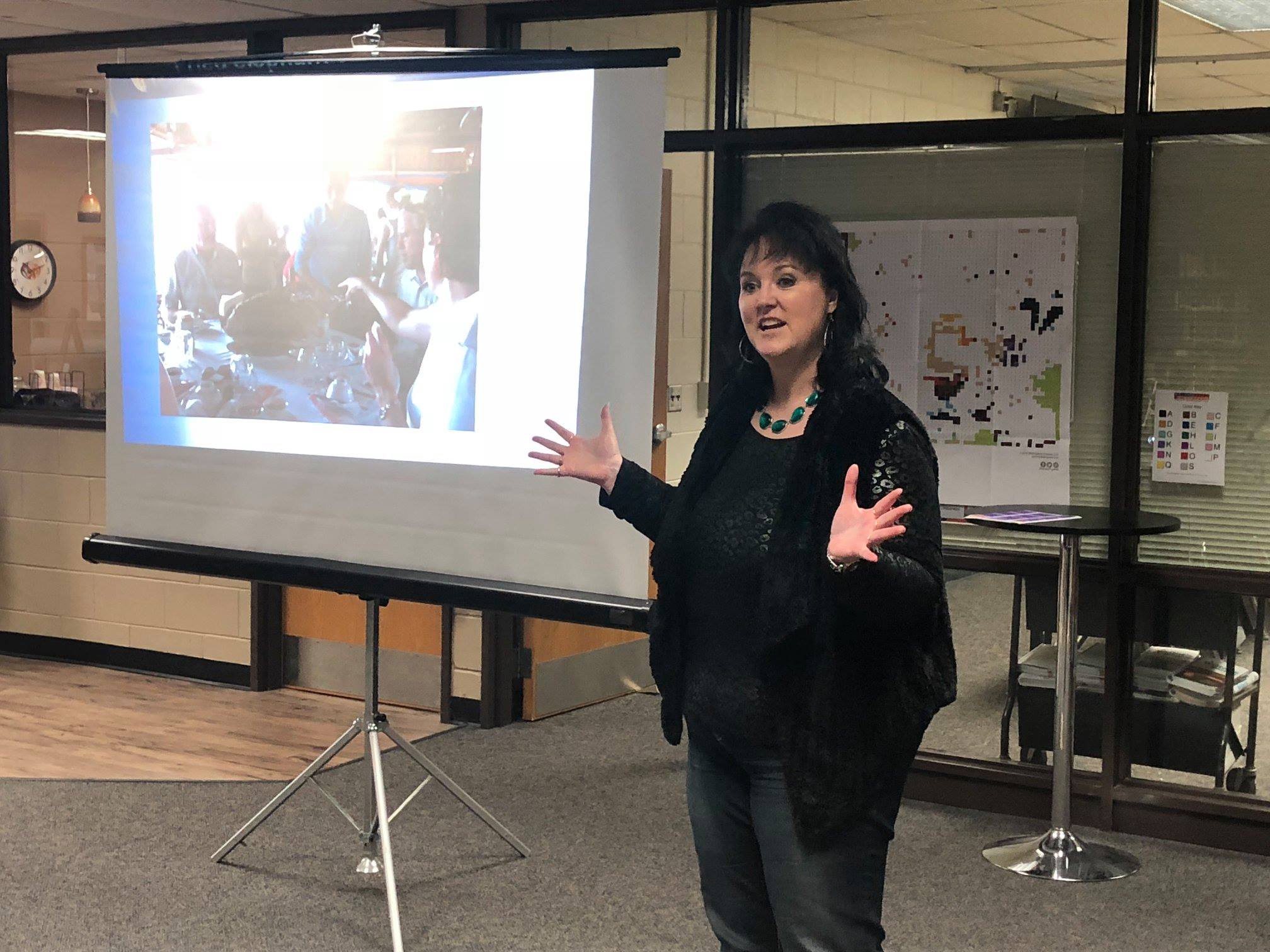
Why We Should Never Stop Asking Why
Ever been asked to speak at career day at the local middle school? If you haven’t, trust me when I say it’s an eye-opening, slightly nerve-wracking experience.
I volunteered with the Calhoun County Farm Bureau to speak at Ag Day on March 26 at the Manson Northwest Webster Middle School about my travels to Vietnam and South Korea a few years ago with the Iowa Corn Growers’ I-LEAD leadership group.
Then I headed west to Sac City on March 29 to share my “True Confessions of an Ag Journalist” program during the Sac County Farm Bureau’s I Am Ag career day, where professionals from veterinarians to bankers spoke about the pros and cons of their careers.
Throughout the day, each speaker is assigned a classroom, and we share our story 12 times in 25-minute segments. I always go home from these events exhausted, but I hope I added value for the students and helped spark their desire to keep learning.
What always amazes me is how different the response is from the sixth graders to the eighth graders. The sixth graders are excited to learn and have no fear of asking questions. In fact, many of them are quick to raise their hands to ask questions and share comments.
Everything changes when the eighth graders walk in the room. Many of these kids want to show you just how bored they are. Some convey clearly through their body language and comments that don’t want to be stuck in a classroom. Their eyes tell you in no uncertain terms that they’re just waiting to defy anyone who dares to challenge them to think and learn.
Undaunted, I tell every group of students I work with that one of the keys to being a successful writer/storyteller/journalist (or any leader, for that matter) is to be like the little kid who never stopped asking why. Always nurture your sense of wonder and curiosity. Not only is that how we learn, but it makes life more fun!
Why do we lose the why?
This experience made me wonder why so many people lose their desire to ask questions.
A Newsweek story, “The Creativity Crisis,” described the signs of declining creativity among our school children. The article noted that preschool kids ask their parents an average of 100 questions a day. WOW! By middle school, however, kids basically stop asking questions.
It is also around this time student motivation and engagement drop like a rock. Why? Our educational system tends to reward students for having the answer, not for asking good questions. Ask a question, and you risk looking ignorant.
Yet knowing how to ask the right questions in the right way is essential to career success, more enjoyable conversations, stronger interpersonal relationships and effective leadership. I can only tell compelling, clear stories for my clients and through my books when I ask the right questions.
 Questions I use
Questions I use
I often work from a tried-and-true, proven set of open-ended questions that encourage sources to open up so we can go beyond the superficial and dig deeper to get to the good stuff—the defining moments, the setbacks, and the dreams that add life and vitality to any story.
Here are some of my key questions
1. What’s some of the best business advice—or advice for life—you’ve ever received?
2. What’s your motivation (for your work, or your life)?
3. What three things inspire you? (These can be people, books, movies, art, places, etc.)
4. What three words describe you?
5. What three words describe your company?
6. What’s something odd/interesting/unique about you? (This fun fact should not be so personal you would only share it with a therapist, but also not so safe it will bore us!)
7. How did you get started in the business you’re in?
8. Think back to when you first hit adulthood. What did you think your life would be like? What was your plan A? Are you still with Plan A, or did you move on to Plan B?
9. What obstacles did you overcome to get where you are today?
10. What’s a specific story of success in your business that drives you to do what you do? (A customer that really affected you, a person you were able to help, an accomplishment you were able to achieve?)
11. What do you like about your work?
12. What helpful lessons did you learn from previous jobs that you apply to your current role?
13. What’s the weirdest thing that’s ever happened to you at work?
14. What’s the best thing that ever happened to you/you witnessed at work?
15. How did your company get started?
16. What excites you about the future?
You can modify these questions (or create your own) and put them to work in your business, your home or your classroom. Please tell me how it goes, too. Don’t be surprised if I ask you why you think these questions work. I love to learn and hope you do to, too!
No matter what, never stop asking “why” about the world around you. We need more critical thinkers. Also remember the words of playwright George Bernard Shaw: “Some men see things as they are, and ask why. I dream of things that never were, and ask why not.”
Want more?
Thanks for stopping by. I invite you to read more of my blog posts if you value intriguing Iowa stories and history, along with Iowa food, agriculture updates, recipes and tips to make you a better communicator.
If you like what you see and want to be notified when I post new stories, be sure to click on the “subscribe to blog updates/newsletter” button at the top of this page, or click here. Feel free to share this with friends and colleagues who might be interested, too.
Also, if you or someone you know could use my writing services (I’m not only Iowa’s storyteller, but a professionally-trained journalist with 20 years of experience), let’s talk. I work with businesses and organizations within Iowa and across the country to unleash the power of great storytelling to define their brand and connect with their audience through clear, compelling blog posts, articles, news releases, feature stories, newsletter articles, social media, video scripts, and photography. Learn more at www.darcymaulsby.com, or e-mail me at yettergirl@yahoo.com.
If you’re hungry for more stories of Iowa history, check out my top-selling “Culinary History of Iowa: Sweet Corn, Pork Tenderloins, Maid-Rites and More” book from The History Press. Also take a look at my latest book, “Dallas County,” and my Calhoun County” book from Arcadia Publishing. Both are filled with vintage photos and compelling stories that showcase he history of small-town and rural Iowa. Order your signed copies today! Iowa postcards are available in my online store, too.
Let’s stay in touch. I’m at darcy@darcymaulsby.com, and yettergirl@yahoo.com.
Talk to you soon!
Darcy
@Copyright 2019 Darcy Maulsby & Co. Blog posts may only be reprinted with permission from Darcy Maulsby.

A Dirty Tip to Make Your Social Media Content More Shareable
Tire turd (noun): Wad of snow, ice, salt and gravel that piles up behind each vehicle tire in the winter. Removable only with explosives. #Iowa #winteriniowa
That’s a recent Facebook post I created when was in Red Oak, Iowa, this week, working on a newsletter for United Farmers Cooperative. When I stopped at the grain elevator, I saw this tire turd on my car. I decided to share it on my personal Facebook page. This silly post apparently struck a chord, because it has been liked 159 times, generated 23 comments and has been shared 17 times. Crazy!
This reminds me of one of the principles I teach in my storytelling classes. Shareability is a key to the most successful social posts.
People don’t just share any old content. Facebook reports that 0.5% of those who see a Facebook post share it. Of all the content links the average Twitter user receives, the re-tweet ratio is 1:318, according to one of my favorite books, “The Content Code,” by Mark Schaeffer.
Research sponsored by the New York Times found that people share content to:
• To be useful, since the info. is practical or timely
• To define themselves to others (look smarter, funnier, more relevant)
• To strengthen relationships with others
• Get the word out about causes, brands, events, etc. they care about
Think about the last time you shared something. What motivated you to do this?
How could you frame your stories and information to make your content more shareable?
Want more?
Thanks for stopping by. I invite you to read more of my blog posts if you value intriguing Iowa stories and history, along with Iowa food, agriculture updates, recipes and tips to make you a better communicator.
If you like what you see and want to be notified when I post new stories, be sure to click on the “subscribe to blog updates/newsletter” button at the top of this page, or click here. Feel free to share this with friends and colleagues who might be interested, too.
Also, if you or someone you know could use my writing services (I’m not only Iowa’s storyteller, but a professionally-trained journalist with 20 years of experience), let’s talk. I work with businesses and organizations within Iowa and across the country to unleash the power of great storytelling to define their brand and connect with their audience through clear, compelling blog posts, articles, news releases, feature stories, newsletter articles, social media, video scripts, and photography. Learn more at www.darcymaulsby.com, or e-mail me at yettergirl@yahoo.com.
If you’re hungry for more stories of Iowa history, check out my top-selling “Culinary History of Iowa: Sweet Corn, Pork Tenderloins, Maid-Rites and More” book from The History Press. Also take a look at my latest book, “Dallas County,” and my Calhoun County” book from Arcadia Publishing. Both are filled with vintage photos and compelling stories that showcase he history of small-town and rural Iowa. Order your signed copies today! Iowa postcards are available in my online store, too.
Let’s stay in touch. I’m at darcy@darcymaulsby.com, and yettergirl@yahoo.com.
Talk to you soon!
Darcy
@Copyright 2019 Darcy Maulsby & Co. Blog posts may only be reprinted with permission from Darcy Maulsby.

Smart Marketing Lessons from an Uber Driver–Listen Up!
Ever used Uber? If you have, I bet your ride was in a city. One of my entrepreneurial friends, Pat, recently started driving for Uber and Lyft here in rural Iowa. Through smart marketing, he’s carving quite a niche.
“I really didn’t realize how much influence the driver has,” Pat told me recently. The other evening, for example, he picked up two guys in a northern Iowa community who said they wanted a ride to the local casual dining/sports bar hangout several blocks away. Then Pat asked, “What do you want to do, eat wings or party?”
“Party!”
“Then we’ll go to a party bar,” Pat said. They agreed, and he drove them 2 miles down the road. He also picked them up again when they were ready to leave.
I love this story, because it highlights some basic keys to successful marketing:
• Take the time to ask the right questions.
• Listen carefully to the answers.
• Help clients reach their goals.
“See, you’re adding value!” I told Pat. “That’s what a great marketer does. You asked the right questions to get to the core of what these guys really wanted, plus you put more money in your pocket. Bravo!”
Marketing takeaway: Asking questions and listening are essential to successful marketing. What key questions do you ask your clients/prospects? Are there more questions you can ask to better serve their needs and become the business partner of choice?
Want more?
Thanks for stopping by. I invite you to read more of my blog posts if you value intriguing Iowa stories and history, along with Iowa food, agriculture updates, recipes and tips to make you a better communicator.
If you like what you see and want to be notified when I post new stories, be sure to click on the “subscribe to blog updates/newsletter” button at the top of this page, or click here. Feel free to share this with friends and colleagues who might be interested, too.
Also, if you or someone you know could use my writing services (I’m not only Iowa’s storyteller, but a professionally-trained journalist with 20 years of experience), let’s talk. I work with businesses and organizations within Iowa and across the country to unleash the power of great storytelling to define their brand and connect with their audience through clear, compelling blog posts, articles, news releases, feature stories, newsletter articles, social media, video scripts, and photography. Learn more at www.darcymaulsby.com, or e-mail me at yettergirl@yahoo.com.
If you’re hungry for more stories of Iowa history, check out my top-selling “Culinary History of Iowa: Sweet Corn, Pork Tenderloins, Maid-Rites and More” book from The History Press. Also take a look at my latest book, “Dallas County,” and my Calhoun County” book from Arcadia Publishing. Both are filled with vintage photos and compelling stories that showcase he history of small-town and rural Iowa. Order your signed copies today! Iowa postcards are available in my online store, too.
Let’s stay in touch. I’m at darcy@darcymaulsby.com, and yettergirl@yahoo.com.
Talk to you soon!
Darcy
@Copyright 2019 Darcy Maulsby & Co. Blog posts may only be reprinted with permission from Darcy Maulsby.
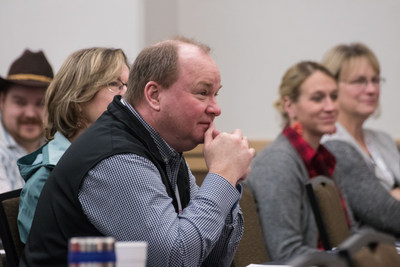
How Not to Invite Someone to Your Next Event–and 3 Solutions
Who’d like to attend another meeting? Not me. You’re probably not looking for another time suck, either. But when you’re the one hosting the meeting, how do you entice people to attend? After all, your meeting is going to be filled with valuable information that will make people glad they stopped by. Don’t miss this!
First, acknowledge the reality of hectic schedules and meeting fatigue—that energy-draining syndrome that infects people who’ve attended one too many unproductive gatherings. I’ve experienced meeting fatigue many a time, and I bet you have, too. That’s why I don’t get overly excited when I get invitations like this:
“It’s time for the XYZ annual meeting! This is your chance to meet with XYZ staff. Find out how area XYZ members are putting our group’s programs to work in their businesses, and see how you can plug in.”
No, thanks. I’ve already got enough on my plate. This invitation isn’t exactly a compelling offer that entices me to mark this event on my calendar. The “benefits” are just too vague.
Don’t waste my time
As a business professional, time is one of my most precious resources. I believe time spent in a meeting (whether it’s in person, online or over the phone) should generate a return on investment. Otherwise, your event isn’t worth it to me, no matter how much I like you or your organization, my friend.
What missed the mark? “Well, wonder no more.”
This is why I just shook my head when I recently received an email invitation that read:
“Who is the keynote speaker at the 2018 National Conference you may wonder? Well wonder no more.”
I’m not sure anyone could have written a weaker lead. My first thought was, “How arrogant! Did this writer really think I’m just waiting to hear who the keynote is for some conference I’ve never heard of before?”
This is the modern business equivalent of the ancient world thinking the sun revolved around the earth. News flash–my world doesn’t revolve around you or your conference. I certainly haven’t been on pins and needles wondering who the keynote speaker could be.
Maybe this is a great event, but what I was reading didn’t show me any reasons to part with my hard-earned dollars and precious time to attend this meeting. I wasn’t even convinced when I scrolled down and saw that the keynote topic was “The Strategic Value of Business Relationships in Agribusiness.” Sounds interesting, but you’re too late. Stop cluttering my inbox. Delete!
3 tips to entice attendees
The whole thing didn’t have to end this way. Stronger writing—the kind that takes the needs and wants of the audience into account—would have worked wonders.
To create this magic, be a bit of a tease. Seduce your audience, if you like. But don’t turn them off. Here are my 3 top tips for writing a meeting invitation to gets results:
1. Make them an offer they can’t refuse. Be clear. Be specific. Be compelling. For example: “Invest two hours with us, and leave with 5 field-tested ideas you can start implementing now to grow your business.” Without a clear path, your offer is limp and unconvincing. Make it easy for people decide that your meeting is worth their time.
2. Satisfy their desires. People are always looking for better ways to save money, make money, save time and enjoy life more. They also like to be informed and entertained. What things motivate your clients, prospects, or members? If you don’t know, find out. Then craft your message by highlighting how time invested at your meeting will help satisfy these desires.
Think back to that ridiculous email invite I received. Here’s how I might have approached this, if I were the writer:
What’s the One ‘Harmless’ Habit You Need to Drop If You Want to Succeed? You’re a busy professional who is in the habit of growing revenues, not relationships, right? But what if you’re overlooking the key to your business’s long-term prosperity—without even realizing it? Bill Jones, president of ABC Agri-Business, knows where you’re coming from. During our annual meeting, he’ll share the most important lesson he’s learned in 30 years of business with “The Strategic Value of Business Relationships in Agribusiness.” If you’re ready to leap ahead of your competition, you won’t want to miss his practical advice in this powerful keynote.
Tell a little story. Speak your readers’ language. Show them what’s in it for them.
3. Seal the deal. Your offer sounds great, but people may still hesitate to sign up for your meeting. Make the decision easier with social proof. Consider this a form of risk management for your audience. Gather testimonials from other people who’ve found value in your meetings. Have them share their stories, in their own words. Take a picture of them, if they don’t mind, and/or shoot a quick video of them sharing their testimonial. Have them explain what challenge they were facing before they attended your event. Then invite them to talk about the value (knowledge, networking opportunities, etc.) they gained by getting involved with your group. Finally, ask how they’ve put this knowledge to work to make their life and/or their business more successful.
Include these stories and testimonials with your invitations. Longer versions can go in email invites or a web page, while a short, concise testimonial might work well on a postcard or letter. In any case, get your audience thinking, “These people are a lot like me. If they’ve benefited from this type of meeting, maybe it’s worth my time, too.”
Let the revolution begin
Now that you know how not to invite someone to your meeting, plus you’ve received 3 top tips to do it right, it’s time for you to lead a meeting revolution.
Show your audience how your next meeting will help them achieve their goals. Prove to them that attending your meeting will be the best investment of their time. Prepare to get more RSVPs (and attendees). Oh, and one more thing—let me know how it goes!
Want more?
Thanks for stopping by. I invite you to read more of my blog posts if you value intriguing Iowa stories and history, along with Iowa food, agriculture updates, recipes and tips to make you a better communicator.
If you like what you see and want to be notified when I post new stories, be sure to click on the “subscribe to blog updates/newsletter” button at the top of this page, or click here. Feel free to share this with friends and colleagues who might be interested, too.
Also, if you or someone you know could use my writing services (I’m not only Iowa’s storyteller, but a professionally-trained journalist with 20 years of experience), let’s talk. I work with businesses and organizations within Iowa and across the country to unleash the power of great storytelling to define their brand and connect with their audience through clear, compelling blog posts, articles, news releases, feature stories, newsletter articles, social media, video scripts, and photography. Learn more at www.darcymaulsby.com, or e-mail me at yettergirl@yahoo.com.
If you’re hungry for more stories of Iowa history, check out my top-selling “Culinary History of Iowa: Sweet Corn, Pork Tenderloins, Maid-Rites and More” book from The History Press. Also take a look at my latest book, “Dallas County,” and my Calhoun County” book from Arcadia Publishing. Both are filled with vintage photos and compelling stories that showcase he history of small-town and rural Iowa. Order your signed copies today! Iowa postcards are available in my online store, too.
Let’s stay in touch. I’m at darcy@darcymaulsby.com, and yettergirl@yahoo.com.
Talk to you soon!
Darcy
@Copyright 2019 Darcy Maulsby & Co. Blog posts may only be reprinted with permission from Darcy Maulsby.

Could Your Story Change Someone’s Life?
Are you a gambler? I’m not. I’ve never even bought a lottery ticket. Maybe it’s because I grew up on a farm. (I learned early on that farming is enough of a gamble—no casino needed!)
Perhaps that’s why I wasn’t listening too closely to a discussion on talk radio recently about online sports betting. It’s a sure bet that sports wagering will be debated this year in the Iowa Capitol.
I was listening to show off and on as I wrote a question-and-answer feature about how FFA influenced Iowa Secretary of Agriculture Mike Naig’s career. The gambling debate wasn’t on my mind—until a story suddenly broke through and froze my fingers on the keyboard.
The radio show’s guest, Tom Coates, told the story of a woman who had called his family’s business, Consumer Credit of Des Moines, when she was caught in the strangling grip of a gambling addiction. Her ordeal had become so overwhelming, so costly and so shameful that she felt she was out of options—other than ending it all.
When she was driving home one night, she decided this was it. She was going to crash her car and end her life. For someone so consumed with despair, it made sense to her.
It just so happened that she had her car radio on during that fateful trip, however. A commercial from Consumer Credit caught her attention. Through a combination of the right message delivered in the right channel at the right time to the right audience, this simple ad (and maybe a serious jolt of divine intervention), stopped this woman from following through with her deadly plan.
She drove to a nearby gas station (this was in the days before everyone had a cell phone) and called Consumer Credit, Iowa’s largest credit counseling service. Consumer Credit’s message of helping people in financial trouble solve their debt problems touched something deep inside her. By dialing the phone, she received the help she needed.
Thanks to a simple radio ad, this woman’s story had a much happier outcome than it could have.
Cutting through the clutter–4 key takeaways
While the stakes usually aren’t this high with most messages we share, that doesn’t mean our stories don’t matter. You will cut through the clutter of this noisy world when you 1.) add value by offering a solution for your audience, 2.) speak human, 3.) strike an emotional chord, and 4.) share your stories consistently through a variety of channels.
You just never know which story or which communication method will connect with the people you’re trying to reach. That’s why it pays to try a variety of formats, from online channels to print publications to audio or video.
Will you be top of mind when someone needs to hear your story? Never underestimate the power of a true story well told. Your story might just matter to someone more than you know.
Want more?
Thanks for stopping by. I invite you to read more of my blog posts if you value intriguing Iowa stories and history, along with Iowa food, agriculture updates, recipes and tips to make you a better communicator.
If you like what you see and want to be notified when I post new stories, be sure to click on the “subscribe to blog updates/newsletter” button at the top of this page, or click here. Feel free to share this with friends and colleagues who might be interested, too.
Also, if you or someone you know could use my writing services (I’m not only Iowa’s storyteller, but a professionally-trained journalist with 20 years of experience), let’s talk. I work with businesses and organizations within Iowa and across the country to unleash the power of great storytelling to define their brand and connect with their audience through clear, compelling blog posts, articles, news releases, feature stories, newsletter articles, social media, video scripts, and photography. Learn more at www.darcymaulsby.com, or e-mail me at yettergirl@yahoo.com.
If you’re hungry for more stories of Iowa history, check out my top-selling “Culinary History of Iowa: Sweet Corn, Pork Tenderloins, Maid-Rites and More” book from The History Press. Also take a look at my latest book, “Dallas County,” and my Calhoun County” book from Arcadia Publishing. Both are filled with vintage photos and compelling stories that showcase he history of small-town and rural Iowa. Order your signed copies today! Iowa postcards are available in my online store, too.
Let’s stay in touch. I’m at darcy@darcymaulsby.com, and yettergirl@yahoo.com.
Talk to you soon!
Darcy
@Copyright 2019 Darcy Maulsby & Co. Blog posts may only be reprinted with permission from Darcy Maulsby.
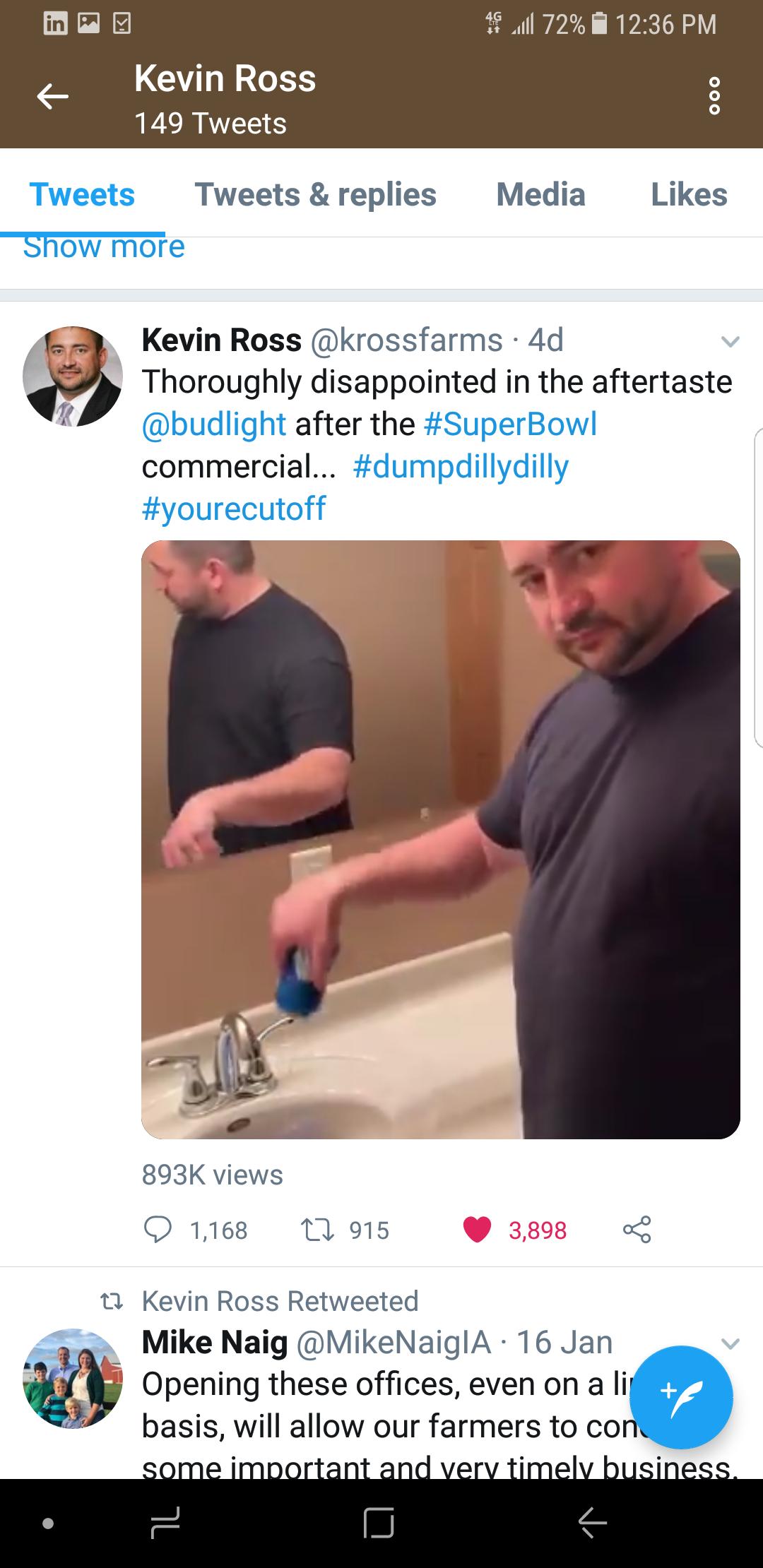
4 Key Lessons from Bud Light’s Super Bowl Corn-troversy
What a difference a day makes. Last Saturday, Feb. 2, I was in Altoona, Iowa, teaching my “Harvest Meals Made Easy” class at the Iowa Farm Bureau’s annual Young Farmer Conference. When I shared my three-ingredient recipe for the tastiest, simplest beer bread around, I noted that the type of beer you use isn’t a big deal, although the friend who shared the recipe with me preferred Bud Light.
Since I’m not much of a beer drinker, I didn’t give Bud Light another thought –until I was watching the Super Bowl last Sunday night.
I tuned in for two main reasons—1.) I’m a Tom Brady fan (see my blog post “Can a True Story Well Told Turn You into a Tom Brady Fan?), and 2.) as a marketer, I like to watch the commercials. I was less than impressed with most of the commercials (you paid more than $5 million for a 30-second spot and only came up with THAT???), although I loved the Microsoft ad “We All Win,” With a story revolving around a young boy from Texas, the ad showcased how Microsoft’s Xbox Adaptive Controller helps children with disabilities enjoy gaming. (This inspiring ad, which nearly brought tears to my eyes, topped the list of “most effective” ads with an UnrulyEQ score of 7.5, according to Ad Week.)
One ad that didn’t impress me was Bud Light’s slam against corn syrup. The ad emphasized that Bud Light doesn’t use corn syrup like competitors’ beers do. I thought it was an odd approach to advertise a mass-produced beer. It also ticked me off, since my family grows corn on our Century Farm, but I figured the stupid ad would just fade away into the wasteland of unremarkable, lame marketing.
I was wrong.
Bud Light versus…corn farmers?
Since I always like to hear what others think about these things, I tuned into the radio when I was headed to Ames the morning after the Super Bowl to attend a soil health conference. The general consensus on talk-radio was that the big game was boring (it was the lowest-scoring game in Super Bowl history), and most of the commercials were boring. No one on those shows was talking about the Bud Light commercial—yet.
But then the story exploded.
One of the first volleys in the battle came when my friend Kevin Ross, a farmer from Minden, Iowa, filmed a 9-second video and posted it to Twitter. As he dumped a can of Bud Light down the bathroom sink, he said, “Bud Light, you’re not standing with corn farmers. We’re not standing with you.”
That simple video helped unleash a media firestorm that led to coverage not only in Iowa media outlets, but Fox Business and other national media organizations. The day after the Super Bowl, the New York Times ran the article, “Bud Light Picks Fight with Corn Syrup in Super Bowl Ad.”
In the Feb. 4 story, Wendy Clark, chief executive of the advertising agency DDB Worldwide, noted that the back-and-forth spat may not have been the best result for Bud Light.
“I don’t know if anyone watching the Super Bowl necessarily cares about corn syrup, and it kicked up much ado about nothing,” Ms. Clark said. “It’s taken off into this corn syrup thing and not a Bud Light thing,” she added, “and I don’t know if that was the goal.”
What were they thinking?
I had to agree as I looked at this not as a farmer, but a storyteller who helps business leaders become thought leaders, attract skilled talent, appeal to more prospects and customers, and drive sales, one story at a time.
A cardinal rule of sharing true stories well told? Know your audience.
Back to Bud Light. Does anyone watching the Super Bowl care that much about corn syrup?
I thought about people I know who drink Bud Light. They tend to be hard-working, middle-class, patriotic Americans who just like to relax at the end of the day with an affordable, refreshing cold beer. They are not worried about corn syrup or health concerns related to excess corn syrup, especially when it comes to beer.
Is Bud Light really that clueless about its consumers?
Or are current Bud Light drinkers really the target audience for Bud Light’s advertisements?
Digging into the story behind the data
The question spurred me to investigate what research reveals about the typical Bud Light drinker.
According to InfoScout.com, which gathers consumer insights and demographics, Bud Light consumers are generally lower income, Hispanic and older. It appears that “older” is the key word that applies not just to Bud Light, but Budweiser, too. A Time.com article in 2014 noted that almost half of millennials had never drunk a Budweiser.
“The flagship Budweiser beer remains popular mostly among older folks, and its parent company, Anheuser-Busch InBev, is refocusing its marketing specifically on the millennial age bracket, the Wall Street Journal reports.”
Dazed and confused
Ahhhhh. I began to suspect what’s going on with the Bud Light corn syrup ad is a classic brand struggling to reinvent itself in a beer market that’s changing fast.
The stakes are high. Consider the 2018 Fortune.com article “Americans Are No Longer Drinking Budweiser and Bud Light Beers Like They Once Did,” which noted that sales of domestic lagers have receded as American consumers turn to craft beers, Mexican imports, wine and spirits to get their buzz.
In July 2018, Anheuser-Busch InBev (which manufactures Budweiser and Bud Light) reported that U.S. revenues fell 3.1 percent in the second quarter. The underperformance resulted in the company missing overall sales growth forecasts, triggering shares to drop more than 5 percent.
What’s going on?
Part of the challenge comes from millennials, who make up a sizeable percentage of legal beer consumers in America today. Millennials are the most skeptical generation in history when it comes to advertising. In an advertising-saturated world, this distrust in marketing hype means authenticity is a driving factor for millennials.
Hence the meteoric rise of craft beer, which is infused with authenticity. Compelling stories of local brewers who combine unique ingredients to brew beer in repurposed historical buildings that become hubs of the community capture the imagination—and beer drinkers’ dollars.
While overall U.S. beer volume sales were down 1 percent in 2017, according to the Brewers Association, craft brewer sales bucked the trend.
• Craft beers continued to grow at a rate of 5 percent by volume, reaching 12.7 percent of the U.S. beer market by volume.
• Retail dollar sales of craft increased 8 percent, up to $26 billion.
• Craft beers now account for more than 23% of the $111.4 billion U.S. beer market.
With all these challenges facing traditional brewers, what’s Bud Light to do? A corn syrup-focused ad during the big game clearly wasn’t the answer.
Backlash in the beer war
My friend Kevin, the corn farmer who serves as first vice president of the National Corn Growers Association, told Yahoo Finance the Bud Light ad “implied that [corn syrup] was an inferior product and that the other beers were doing something wrong because they use corn syrup in the brewing process,” and called it an “attack.”
Miller Lite took out a full-page ad in the New York Times on Feb. 6, stating in part, “The ‘corn syrup’ we source from America’s heartland helps make Miller Lite taste so great… It’s unfortunate that our competitor’s Big Game ad created an unnecessary #corntroversy.”
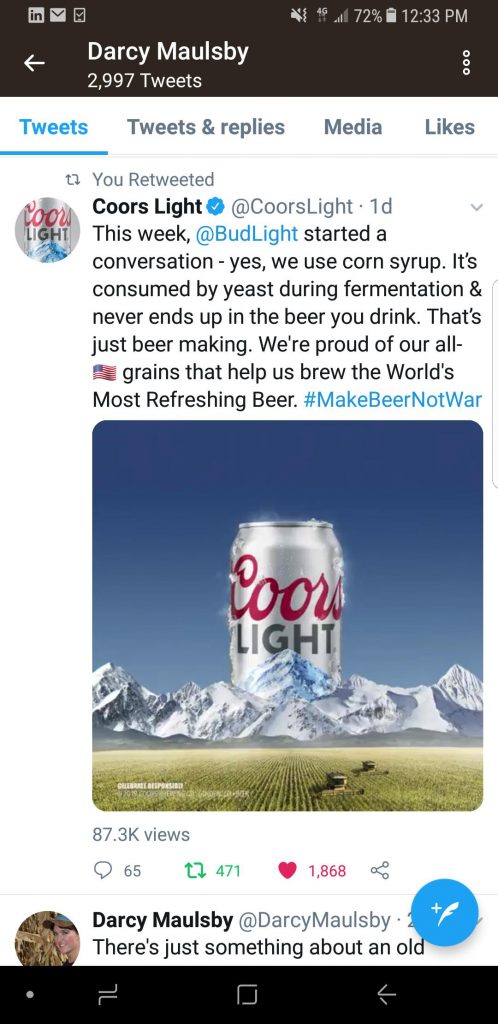 Also on Feb. 6, Coors Light tweeted, “This week, Bud Light started a conversation –yes, we use corn syrup. It’s consumed by yeast during fermentation & never ends up in the beer you drink. That’s just beer making. We’re proud of our all-American grains that help us brew the World’s Most Refreshing Beer. #MakeBeerNotWar”
Also on Feb. 6, Coors Light tweeted, “This week, Bud Light started a conversation –yes, we use corn syrup. It’s consumed by yeast during fermentation & never ends up in the beer you drink. That’s just beer making. We’re proud of our all-American grains that help us brew the World’s Most Refreshing Beer. #MakeBeerNotWar”
It didn’t take long before Bud Light began backtracking. In a tweet on Feb. 6, presented as a note from the king character from the ad, Bud Light said, “Yeesh! That escalated quickly… In the Bud Light Kingdom we love corn too! Corn on the cob, corn bread, popcorn—we just don’t brew with the syrup (what you also call ‘dextrose’).”
I’ll drink to that
So what can we take away from the Bud Light corn-troversy?
1. Know your audience.
2. Authenticity matters.
3. You don’t control your message, especially in a world of social media.
4. Instead of contrived marketing hype, tap into the power of true stories well told.
Want more?
Thanks for stopping by. I invite you to read more of my blog posts if you value intriguing Iowa stories and history, along with Iowa food, agriculture updates, recipes and tips to make you a better communicator.
If you like what you see and want to be notified when I post new stories, be sure to click on the “subscribe to blog updates/newsletter” button at the top of this page, or click here. Feel free to share this with friends and colleagues who might be interested, too.
Also, if you or someone you know could use my writing services (I’m not only Iowa’s storyteller, but a professionally-trained journalist with 20 years of experience), let’s talk. I work with businesses and organizations within Iowa and across the country to unleash the power of great storytelling to define their brand and connect with their audience through clear, compelling blog posts, articles, news releases, feature stories, newsletter articles, social media, video scripts, and photography. Learn more at www.darcymaulsby.com, or e-mail me at yettergirl@yahoo.com.
If you’re hungry for more stories of Iowa history, check out my top-selling “Culinary History of Iowa: Sweet Corn, Pork Tenderloins, Maid-Rites and More” book from The History Press. Also take a look at my latest book, “Dallas County,” and my Calhoun County” book from Arcadia Publishing. Both are filled with vintage photos and compelling stories that showcase he history of small-town and rural Iowa. Order your signed copies today! Iowa postcards are available in my online store, too.
Let’s stay in touch. I’m at darcy@darcymaulsby.com, and yettergirl@yahoo.com.
Talk to you soon!
Darcy
@Copyright 2019 Darcy Maulsby & Co. Blog posts may only be reprinted with permission from Darcy Maulsby.

Can a True Story Well Told Turn You into a Tom Brady Fan?
Ever had that experience where you thought you know someone well, and then something that person says or does throws you for a loop? It happened to me last week when one of my clients, who has also become one of my dear friends, brought up Tom Brady.
We were brainstorming story ideas for her company’s magazine when my friend turned the conversation to the New England Patriots’ quarterback. She became more animated as she talked about why Brady is such a great guy.
“You really need to watch this video,” says my friend, who texted me the link to the 47-minute documentary “The Brady 6 – The #199 Draft Pick Tom Brady Story.”
Sure, I knew the basics about Brady (good-looking guy, married to a supermodel, a father, an amazing athlete who has led his team to multiple Super Bowl victories—the kind of guy lots of people love to hate).
But my friend wouldn’t stop talking about Brady-and I was fascinated. This is a lady who admits she had no interest—zero—in football before she got hooked on Brady.
It wasn’t Brady’s looks, his athletic ability or his NFL statistics that captured her imagination. It was his story. This unlikely football fan couldn’t resist an underdog story defined by compelling characters, high stakes, uncertain outcomes and someone with the heart of a champion who never gives up.
“I like Tom Brady’s story so much that I saved the Brady 6 video and still watch it from time to time,” my friend confides to me.
I didn’t really know Brady’s back story, so I took my friend’s advice and watched the Brady 6 documentary. The Brady 6 refers to the 6 quarterbacks selected before Brady, who was the 199th pick overall in the 2000 NFL draft. The fact that no one saw his true potential during the NFL draft didn’t stop Brady from becoming one of the greatest quarterbacks of all time.
Brady is still on top of his game 19 years after being drafted. Now in his 40s, he’s doing things never seen before in the NFL. He’s still leading his team to Super Bowls, winning MVP awards, and doing it at an age when most quarterbacks have moved on to the TV booth or disappeared into obscurity.
All this is what transformed my friend into a Tom Brady fan who loves the Patriots’ football. “Every year I try to learn more about the game,” she says with so much passion and enthusiasm that I wonder if I’m really talking to this friend I thought I knew so well. Can this really be the lady who has had a successful 40-year career and starts thinking about retirement a little more each year? Who is this demure magazine editor-turned-football fan?
“So do you buy Patriots’ stuff?” I ask.
“Are you kidding? I have Patriots everything, from shirts to socks. I even made a point to go to Foxborough (Massachusetts) last fall for my first Patriots’ game when I was in New England for a journalism conference.”
She just couldn’t help herself. “Oh, that was great!” she exclaims. “It was just wonderful to be around all those Patriots fans—and the Patriots beat the Dolphins!”
My friend’s devotion hasn’t stopped with purchases of Patriots gear and game tickets. She has also downloaded the Patriots’ smartphone app to keep up with the team, and she listens to the Patriots’ radio show faithfully.
“And now I know a lot of stories of the other players, too,” she proclaimed. “I really love this team!”
I have to admit—because of my friend’s enthusiasm and her word-of-mouth marketing, I’ve become a Tom Brady fan, too, and will be cheering on the Patriots this Sunday.
What’s your Tom Brady story?
My friend’s Tom Brady story reminds me of a timeless marketing truth—never underestimate the power of a true story well told.
The best part is that we all have our own Tom Brady stories to tell. True stories of perseverance, excellence, overcoming adversity, and using our talents to make the world a more interesting, enjoyable place.
Are you trying to grow your customer base? Seeking more donations or volunteers to support your non-profit organization? Want to be perceived as a thought leader? Uncovering your unique stories, framing them in a way that resonates with your audience and sharing them can help you cut through the marketing clutter and stand out in the best possible way.
I’d love to help you discover and craft the stories that help you add value to your audience and make a positive difference in your world. Let’s start the conversation.
Oh—one more thing. Whether you watch the Super Bowl for the football or the commercials, enjoy the big game!
Want more?
Thanks for stopping by. I invite you to read more of my blog posts if you value intriguing Iowa stories and history, along with Iowa food, agriculture updates, recipes and tips to make you a better communicator.
If you like what you see and want to be notified when I post new stories, be sure to click on the “subscribe to blog updates/newsletter” button at the top of this page, or click here. Feel free to share this with friends and colleagues who might be interested, too.
Also, if you or someone you know could use my writing services (I’m not only Iowa’s storyteller, but a professionally-trained journalist with 20 years of experience), let’s talk. I work with businesses and organizations within Iowa and across the country to unleash the power of great storytelling to define their brand and connect with their audience through clear, compelling blog posts, articles, news releases, feature stories, newsletter articles, social media, video scripts, and photography. Learn more at www.darcymaulsby.com, or e-mail me at yettergirl@yahoo.com.
If you’re hungry for more stories of Iowa history, check out my top-selling “Culinary History of Iowa: Sweet Corn, Pork Tenderloins, Maid-Rites and More” book from The History Press. Also take a look at my latest book, “Dallas County,” and my Calhoun County” book from Arcadia Publishing. Both are filled with vintage photos and compelling stories that showcase he history of small-town and rural Iowa. Order your signed copies today! Iowa postcards are available in my online store, too.
Let’s stay in touch. I’m at darcy@darcymaulsby.com, and yettergirl@yahoo.com.
Talk to you soon!
Darcy
@Copyright 2019 Darcy Maulsby & Co. Blog posts may only be reprinted with permission from Darcy Maulsby.

Finding Your Voice: The Story You Never Knew About “I Have a Dream”
Why do we still remember the powerful words of Martin Luther King Jr.’s “I Have a Dream” speech? Because he skipped the script.
The night before the speech, Tuesday, August 27, 1963, seven people, including Clarence Jones, a speechwriter, gathered with King at the Willard Hotel in Washington, D.C., to add their input to the final speech. King asked Jones to take notes and to turn them into cohesive remarks he would deliver on the steps of the Lincoln Memorial the next day.
“I tried to summarize the various points made by all of his supporters,” Jones recalled. “It was not easy; voices from every compass point were ringing in my head.”
The next morning King’s speech was finished and copies were delivered to the press. Fast forward a few hours later, when King was delivering the speech. If you’ve seen the film footage, you’ll notice that King looked down a lot in the first part of the speech, because he was reading the text.
But by the seventh paragraph, something extraordinary happened.
King paused.
In that brief silence, Mahalia Jackson, a gospel singer and good friend of King’s, shouted “tell ‘em about the ‘dream.’” Few people heard her, although King did. He pushed the text of his prepared remarks to one side of the lectern. He shifted gears in a heartbeat, abandoning whatever final version he’d prepared.
King improvised much of the second half of the speech, including the “I have a dream” refrain. King rarely looks down in the second half of the speech. It’s because he’s not reading; he’s riffing, like a jazz musician. And it was nothing short of soul-stirring.
Find your authentic voice
How does this apply to you? If you want to inspire your listeners (or readers), consider your audience, without a doubt, but find your authentic voice as you share your story.
Ask yourself, “What is it about my topic that makes my heart sing?” The answer will reflect your authentic voice and will connect with your listeners on a deeper, more emotional, more unforgettable level. You never know the impact your words can have. You just might make history.
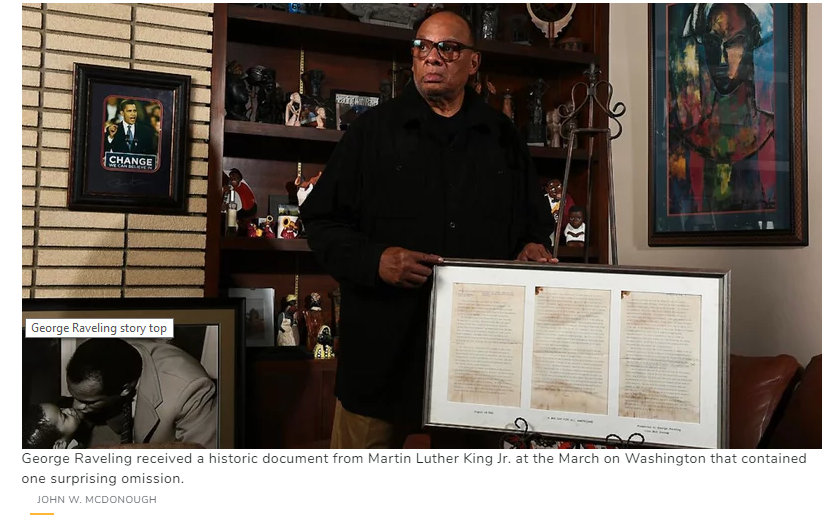
The story of how George Raveling, former men’s basketball coach at the University of Iowa, is intertwined with Martin Luther King Jr.’s famous “I Have a Dream” speech. Photo credit: Sports Illustrated
The Iowa connection
One more thing–there is a remarkable Iowa connection to this powerful story. It involves legendary basketball coach George Raveling, who coached men’s basketball at the University of Iowa in the 1980s. He has a copy of the famous speech, given to him by Martin Luther King, Jr. himself after the he delivered his immortal words on the steps of the Lincoln Memorial.
The story was retold in “Pioneering coach George Raveling’s surprising connection to MLK,” which ran in a 2015 issue of Sports Illustrated. Here’s a snippet:
“There is, however, one souvenir so special that Raveling stores it separately, at a secure location. The item is worth millions of dollars, but he will not sell it. It is too -important — to him, to his race and to his country.
Raveling acquired his most prized possession on Aug. 28, 1963, while standing on the steps of the Lincoln Memorial. Perhaps you recall what occurred on that date at that place: the March on Washington for Jobs and Freedom, the demonstration that culminated in a defining moment for the civil rights movement. Raveling didn’t decide to go to the march until two days before, yet he emerged from that trip with the three pieces of paper that lay on the podium while the final speaker delivered one of the most important addresses in U.S. history.
To understand how Raveling ended up next to the speaker, and why he refuses to cash in on his priceless memento, you have to rummage through his collection, run your finger along the road map and piece together the parallel lives of two men, one a preacher, the other a coach. Theirs is a story of history and happenstance, linked by a surreal moment that sprang from a dream.”
Read the rest of the story–and the all-important Iowa connection–here.
Want more?
Thanks for stopping by. I invite you to read more of my blog posts if you value intriguing Iowa stories and history, along with Iowa food, agriculture updates, recipes and tips to make you a better communicator.
If you like what you see and want to be notified when I post new stories, be sure to click on the “subscribe to blog updates/newsletter” button at the top of this page, or click here. Feel free to share this with friends and colleagues who might be interested, too.
Also, if you or someone you know could use my writing services (I’m not only Iowa’s storyteller, but a professionally-trained journalist with 20 years of experience), let’s talk. I work with businesses and organizations within Iowa and across the country to unleash the power of great storytelling to define their brand and connect with their audience through clear, compelling blog posts, articles, news releases, feature stories, newsletter articles, social media, video scripts, and photography. Learn more at www.darcymaulsby.com, or e-mail me at yettergirl@yahoo.com.
If you’re hungry for more stories of Iowa history, check out my top-selling “Culinary History of Iowa: Sweet Corn, Pork Tenderloins, Maid-Rites and More” book from The History Press. Also take a look at my latest book, “Dallas County,” and my Calhoun County” book from Arcadia Publishing. Both are filled with vintage photos and compelling stories that showcase he history of small-town and rural Iowa. Order your signed copies today! Iowa postcards are available in my online store, too.
Let’s stay in touch. I’m at darcy@darcymaulsby.com, and yettergirl@yahoo.com.
Talk to you soon!
Darcy
@Copyright 2019 Darcy Maulsby & Co. Blog posts may only be reprinted with permission from Darcy Maulsby.


